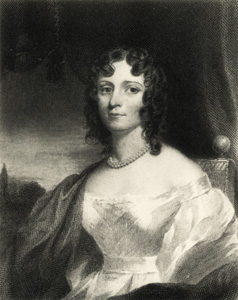Felicia Hemans was born on September 25, 1793 in Liverpool, England to George Brown and Felicity Wagner. Early in Felicia’s childhood, the family moved to North Wales where she spent the majority of her early years. Felicia, at a young age, was fluent in Latin, German, French, and Italian and was known as a child prodigy. She began writing poetry to help with financial issues after her father abandoned the family when he emigrated to Quebec. This writing proved to be more than just a child’s hobby because at the age of 14, she published her first volume of poetry, and by the time she was 18, she had published her third volume of poetry. Writing had become her career, a career that would prove successful for this young woman.
At 19 years of age, Felicia married Captain Alfred Hemans of the Fourth or King’s Own Regiment who was a survivor of the Peninsular Campaign. Within 6 years of their marriage, Felicia had bore Captain Hemans five sons and managed to still publish four more volumes of poetry. Captain Hemans, supposedly “ill,” left for Italy right before the birth of their sixth son. Felicia, just like the story of her mother, had been abandoned and left to care for the family on her own and would never see her husband again. Unable to continue writing and take on the roles that motherhood demanded, Felicia and her sons moved to North Wales to live with Felicia’s mother. Needing to provide financially for the family, Felicia focused on writing poetry while her mother took on the responsibility of raising her grandsons. The time that Felicia spent on her writings proved to be very successful for her.
In literary circles of the nineteenth century, Felicia Hemans was “one of the most widely read, widely published, and professionally successful poets” that seemed to “epitomize the ‘poetess’ as a woman speaking to women” (Wolfson 128). Much of her popularity was gained between 1820 and 1835 when she began contributing greatly to annuals and other literary magazines. Though she had some success in writing plays and longer poems, the great success and reception she found in writing shorter poems for annuals changed her style and perspective on writing. The development of the annual served as an avenue for women writers to earn money because with women readership in mind, “the annuals purveyed a medley of relentlessly charming, mutually illustrative engravings and texts, which were so successfully calibrated to maximize consumer pleasure that they set the pattern for their current descendant, the best-selling coffee-table book” (Tucker 525) and as Mellor points out, “these best-sellers systematically constructed through word and picture the hegemonic ideal of feminine beauty” (111). Felicia, after some failures, caught on to the tastes of the annuals’ readers, and realized how much her writing was influenced by the economic factors at hand when she states, “I have now seen how little any work of mere sentiment or description is likely to obtain popularity, and have had warning enough to give up that style of writing altogether” (Feldman 76).
The popularity and success of the annuals can most likely be attributed to the interest that women found in them. The Romantic Period proved to be a time of conflict between the domestic sphere and the public sphere and women poets, in tune with this conflict in their own lives were able to address the issue in their writing. Ross states in his article: “For Hemans, each major poem becomes a reworking of this troublesome conflict, each time resolving the conflict with a persistence that demonstrates how unsettling the conflict itself is to her psyche” (289-290). Nevertheless, Felicia found great success in this medium of literature.
In 1827, with her mother’s death, there began a steady decline in Felicia’s writing because of the devastation of the event. Not only did it take its toll on her mentally, but physically as well which many believe led to her early death at the age of 41 in 1835. Even after her death, Felicia’s popularity continued through the nineteenth century. Her most famous work is the poem entitled “Casabianca.”
|

